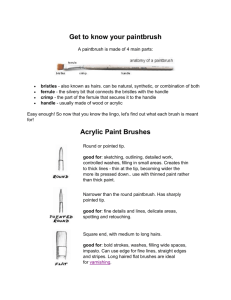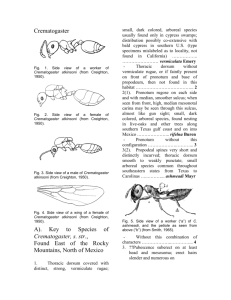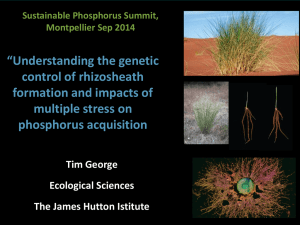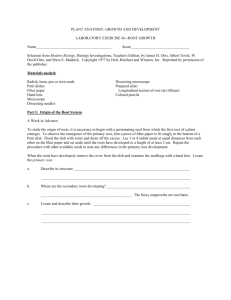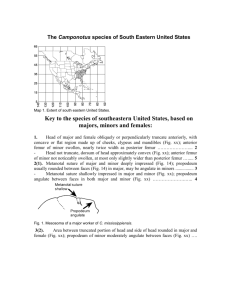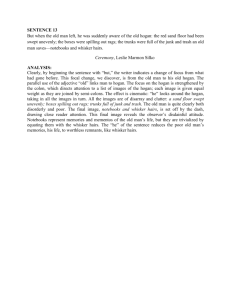IDENTIFICATION KEYS OF THE THREE CASTES
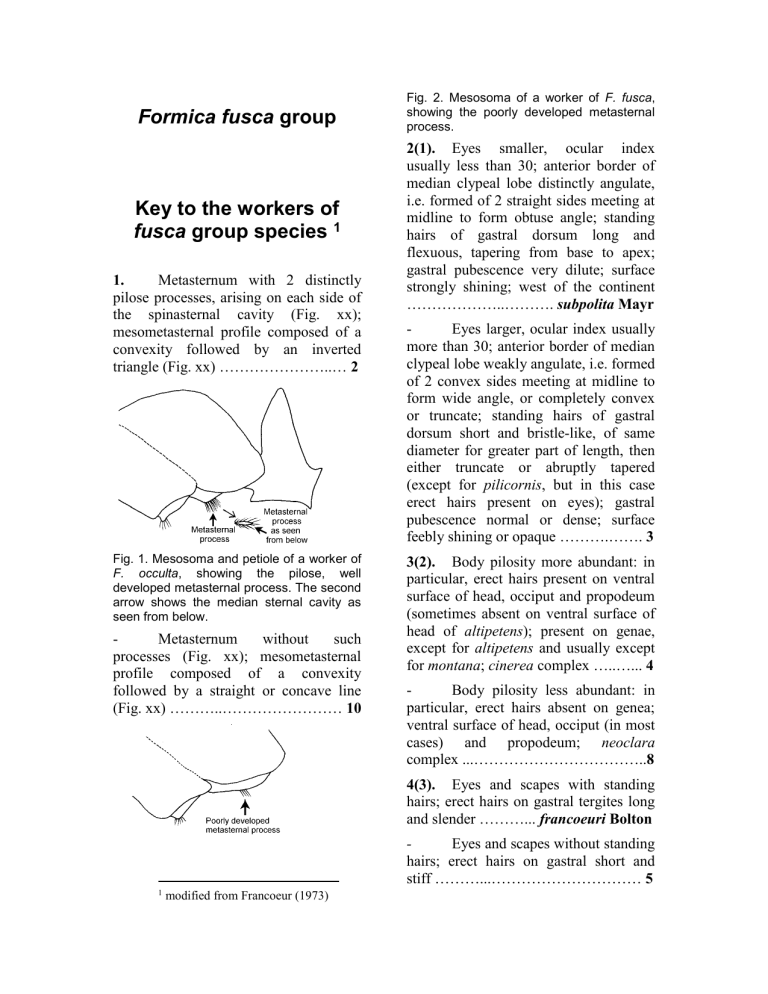
Formica fusca group
Key to the workers of
fusca group species
1
1.
Metasternum with 2 distinctly pilose processes, arising on each side of the spinasternal cavity (Fig. xx); mesometasternal profile composed of a convexity followed by an inverted triangle (Fig. xx) …………………..… 2
Fig. 1. Mesosoma and petiole of a worker of
F. occulta , showing the pilose, well developed metasternal process. The second arrow shows the median sternal cavity as seen from below.
- Metasternum without such processes (Fig. xx); mesometasternal profile composed of a convexity followed by a straight or concave line
(Fig. xx) ………..…………………… 10
1 modified from Francoeur (1973)
Fig. 2. Mesosoma of a worker of F. fusca , showing the poorly developed metasternal process.
2(1).
Eyes smaller, ocular index usually less than 30; anterior border of median clypeal lobe distinctly angulate, i.e. formed of 2 straight sides meeting at midline to form obtuse angle; standing hairs of gastral dorsum long and flexuous, tapering from base to apex; gastral pubescence very dilute; surface strongly shining; west of the continent
………………..………. subpolita Mayr
- Eyes larger, ocular index usually more than 30; anterior border of median clypeal lobe weakly angulate, i.e. formed of 2 convex sides meeting at midline to form wide angle, or completely convex or truncate; standing hairs of gastral dorsum short and bristle-like, of same diameter for greater part of length, then either truncate or abruptly tapered
(except for pilicornis , but in this case erect hairs present on eyes); gastral pubescence normal or dense; surface feebly shining or opaque ……….…….
3
3(2).
Body pilosity more abundant: in particular, erect hairs present on ventral surface of head, occiput and propodeum
(sometimes absent on ventral surface of head of altipetens ); present on genae, except for altipetens and usually except for montana ; cinerea complex …..…... 4
- Body pilosity less abundant: in particular, erect hairs absent on genea; ventral surface of head, occiput (in most cases) and propodeum; neoclara complex ...……………………………..
8
4(3).
Eyes and scapes with standing hairs; erect hairs on gastral tergites long and slender ………...
francoeuri Bolton
- Eyes and scapes without standing hairs; erect hairs on gastral short and stiff ………...………………………… 5
5(4).
Episterna without erect or suberect hairs; if a few (1 to 3) are present, these limited to peripheral margin of mesothoracic katepisterna; genae and usually occipital angles without erect hairs; sometimes erect hairs absent on ventral surface of head and crest of petiole; west of the continent ……….…
altipetens Wheeler
Fig. 4. Head of a worker of F. montana . The arrow indicates the lack of hairs on the side of the head anterior to the eye (malar area), the second arrow indicates the hairs on the cheek.
Fig. 3. Head of a worker of F. altipetens , showing the lack of erect hairs on the posterior lateral angles and cheek.
- Episterna with erect suberect hairs (except for montana in some cases); genae with erect hairs, frequently absent on montana ; occipital angles usually pilose ………………………...
6
6(5).
Sides of head less pilose; head in full face view, erect hairs usually limited to occipital angles, but may be present down to the ventral border of eyes; genae normally without erect hairs, sometime 1-2 near the tentorial fossa; occipital angles becoming glabrous in western part of its range; eastern center of the continent …....
montana Wheeler
Fig. 5. Head of a worker of F. montana , as seen from the side.
- Sides of head more pilose; head in full face view, with erect hairs present below ventral border of eyes; genae normally with more than 2 erect hairs
……..………………………………….
7
7(6).
Body brownish or blackish brown; density of pubescence normal to feeble; integument slightly shining, particularly on head and gaster; ocular halo distinct, but weakly shining; scapes shorter, scape length minus head length varying from – 0.20 to – 0.03 mm; west and western center of the continent …..
……………..…… canadensis Santschi
Fig. 6. Head of a worker of F. canadensis , showing the erect hairs on the side of the head anterior to the eye.
- Body black; pubescence very dense; integument opaque, appearing granulose; without ocular halo; scapes longer, scape length minus head length varying from – 0.03 to + 0.08 mm;
México ..……………. pulla Francoeur
8(3).
Body concolorous black or brownish black; dorsal margin of petiole low and convex or angulo-convex (Fig.
25, 28), median portion entire or weakly emarginate on largest workers; propodeal angle distinct; southwest of continent …….….… occulta Francoeur
Fig. 7. Head of a worker of F. occulta , as seen from the side.
- Body brownish to yellowish, usually appearing bicolored; dorsal margin of petiole and propodeal angle having a different combination of characters …………………………….
9
9(8).
Dorsal margin of petiole high and angulo-convex, rarely with median notch; propodeal angle distinct; usually more than 5 erect hairs on promesonotum; México ………………..
………………..… propatula Francoeur
- Dorsal margin of petiole low and convex, usually with median notch; propodeal angle reduced to even convexity; without erect hairs on promesonotum (except in Idaho), sometimes 1 to 3 small hairs on pronotum; from Yukon to Texas
………………………..
neoclara Emery
10(1).
Body concolorous: black, blackish or yellowish brown; if appearing bicolored, mesosoma yellow and very pilose or mesosoma reddish and upper half of head black ……….. 11
- Body bicolored: head, mesosoma and petiole reddish or reddish brown, gaster black or blackish brown; surface opaque and granulose (except in F. gnava and F. foreliana , but then propodeum is depressed compared to promesonotum); southern half of the continent; rufibarbis and occidua complexes ………………………..…
28
11(10).
Portion of gena lying between eye and insertion of mandible covered with coarse, elongate punctures, widely spaced in posterior half of gena (Fig. xx); surface between them with microreticulum composed of coarse lines readily seen under low magnification; pilosity on gastral dorsum very short and pubescence dilute at least on posterior half; metasternal pilosity abundant and surrounding spinasternal cavity; neorufibarbis complex ……….…….. 12
- Genae without coarse, elongate punctures, or if present, punctures are mostly concentrated on posterior half of genae, where they are mixed with fine, circular punctures and are closely spaced
(Fig. xx); surface between them with microreticulum composed of delicate lines hardly seen under low magnification; pilosity and pubescence variously combined …………...……
13
12(11).
Body pilosity abundant: in particular, erect hairs numerous on ventral surface of head and metafemora, occiput, prosternum, mesosoma, dorsal margin of petiole and gastral dorsum; varying from 8 - 27 (mean = 17) on first gastral segment not counting posterior row; sometimes erect hairs absent on ventral surface of head and metafemora, and dorsal margin of petiole among few
workers of colony; body brownish black or black ……….….….
hewitti Wheeler
Fig. 8. Dorsal surface of the mesosoma and petiole of a worker of F. hewitti , showing the presence of erect hairs.
- Body pilosity reduced: in particular, erect hairs absent on ventral surface of head, occiput, prosternum, mesosoma and dorsal margin of petiole; in toundra form specimens, 1 - 5 erect hairs may be present on mentioned structures, except petiole; pilosity of gastral dorsum reduced; erect hairs from
0 - 13 (mean = 2) on first gastral segment, not counting posterior row; posterior half of head and gaster black, anterior half of head and mesosoma usually reddish ... neorufibarbis Emery
Fig. 9. Side of head of a worker of F. neorufibarbis , showing the elongate punctures between the eye and the base of the mandible.
Fig. 10. Dorsal surface of the mesosoma and petiole and petiole of a worker of F. neorufibarbis , showing the near lack of erect hairs (note 2 hairs are present).
13(11).
Body pilosity abundant: in particular, erect hairs present on ventral surface of head and metafemora, occiput, promesonotum, dorsal margin of petiole and propodeum (except in F. subcyanea ); west and south of the continent …………………………….
14
- Body pilosity reduced: in particular, erect hairs absent on propodeum, dorsal margin of petiole and at least on 1, 2 or 3 of other mentioned structures ………………………….... 20
14(13).
Body concolorous black; surface opaque and finely granulose; erect hairs absent propodeum, very short and large on gastral dorsum; México …….….……
……………………
subcyanea Wheeler
- Body yellowish to blackish brown; mesosoma often lighter in color than head and gaster; surface feebly shining and shagreened; erect hairs present on propodeum; on gastral dorsum erect hairs longer and finer; west and south of continent; lepida complex
………………………………………
15
15(14).
Erect or suberect hairs present on
4 faces of femora (Fig. xx); petiolar scale seen in profile thick and rounded at summit; California ... lepida Wheeler
- Erect or suberect hairs limited to ventral and lateral faces of femora (Fig. xx); petiolar scale seen in profile thinner and angulate at summit …………..…
16
16(15).
Episterna, occipital angles and genae with erect hairs ………………
17
- Episterna, occipital angles and genae without erect hairs …………...
19
17(16).
Dorsal margin of petiole high and narrow, angulate or angulo-convex, entire (Fig.28 - 29); scapes shorter than head length, scape index 108 - 118;
México ……… pachucana Francoeur
- Dorsal margin of petiole low and broad, convex; scapes length varying
…………………………………….... 18
18(17).
Head more elongate, cephalic index 82 - 87; scapes longer than head, scape index 116 - 130; crest of petiole with median notch; length of longest pronotal hairs less than height of frontal triangle; from British Columbia to
California .…
transmontanis Francoeur
- Head less elongate, cephalic index 87 - 91; scapes shorter than head, scape index 97 - 109; crest of petiole entire; length of longest pronotal hairs more than height of frontal triangle;
California ….…. longipilosa Francoeur
19(16). Head rounded and broader or trapezoidal, with convex sides, cephalic index 85 - 96; scapes shorter (Fig. xx), scape length minus head length varying from - 0.14 to - 0.05 mm, scape index 96
- 117; anterior margin of clypeus convex; crest of petiole usually entire
………………...……
aerata Francoeur
- Head rectangular and narrower, with straight sides, cephalic index 72 -
88; scapes longer, scape length minus head length varying from - 0.04 to +
0.08 mm, scape index 114 - 129; anterior margin of clypeus angulate and prominent in middle; crest of petiole usually with median notch .……….......
............…………… pacifica Francoeur
20(13).
Upper surface of body shagreened, shining at least on some parts of head, and never granulose; punctures of frons coarser, readily seen under low magnification, interspaces large and shining (less evident on F. argentea because pubescence is very dense); large, elongate punctures beneath and behind eyes (except on F. argentea ); propodeum higher, with basal and declivitous faces distinct and forming in general a well marked angle
…………………………………….…
21
- Upper surface of body opaque and granulose; punctures of frons finer, difficult to locate under high magnification, interspaces very reduced; without large, elongate punctures beneath and behind eyes; propodeum depressed, without distinct angle, basal and declivitous faces forming single, even convexity; west of continent; sibylla complex ...………..…………. 27
21(20).
Pilosity abundant on first gastral tergite: rarely fewer than 10 erect hairs
(mean = 20), exclusive of the posterior row (Figs. xx), distance between hairs of this row usually inferior or equal to their length; metasternum less pilose, hairs not surrounding spinasternal cavity and generally restricted behind it; mesothoracic katepisterna of female completely covered with normal or dense pubescence; subsericea complex
…………………………….…………
22
- Pilosity reduced on first gastral tergite: rarely more than 10 erect hairs
(mean = 4), exclusive of posterior row
(Fig. xx), distance between hairs of this row usually superior to their length; metasternum more pilose, hairs surrounding spinasternal cavity; mesothoracic katepisterna of female with very dilute pubescence at least in center; fusca complex …………………….... 25
22(21).
Pubescence dense to very dense on genae and first 4 gastral tergites; large, elongate punctures absent on genae beneath and behind eyes (Fig. xx); pronotum usually with some short, erect hairs; gastral dorsum with numerous short and somewhat swollen, erect hairs
(Fig. xx); from 10 - 43 (mean = 23) erect hairs on first tergite, exclusive of posterior row (Fig. xx); blackish brown to brown ………..….
argentea Wheeler
Fig. 11. Dorsal surface of the first gastral tergum of a worker of F. argentea .
- Pubescence dilute to normal on fourth gastral tergite and on genae at least on posterior half; large, elongate punctures present on genae beneath and behind eyes (Fig. xx); black to piceous black ………………………………... 23
23(22).
Scapes not shorter than head length (Fig. xx); head more rounded; occipital margin distinctly convex, becoming straight medially on largest workers; frontal carinae shorter, usually bent mesad at posterior ends; pubescence normal on first 3 gastral tergites; without erect hairs on pronotum, sometimes 1 - 3 very short; in most cases from 10 - 25 (mean = 18) erect hairs on first gastral tergite exclusive of posterior row (Fig. xx); larger species, mesosoma length 1.80 -
2.95 mm (mean = 2.37 mm); east of continent ………………
subsericea Say
- Scapes often shorter than head length (Fig. xx); head more trapezoidal, occipital margin straight, becoming slightly convex on smaller workers; frontal carinae longer, bent laterad at posterior ends or straight; pubescence and pilosity differently combined; smaller species, mesosoma length 1.55 -
2.60 mm (mean = 2.08 mm) ………..
24
24(23).
Promesonotum normally without erect hairs, exceptionally 1 - 6 on pronotum; gastral pubescence normal on first and second tergites, rarely dilute on the posterior half of second, dilute on others; first gastral tergite with 8 to 32
(mean = 17) erect hairs exclusive of the posterior row; northeast of continent
.......………......……..
glacialis Wheeler
- Promesonotum normally with erect hairs, sometimes reduced in number (mean = 6) or abraded on some workers of colony, sometimes 1 - 2 on ventral surface of head; gastral pubescence usually moderately dense or normal on first 3 tergites, dilute on others; first gastral tergite with 15 - 45
(mean = 26) erect hairs exclusive of posterior row (Fig. xx) ……..…………
………………..…
podzolica Francoeur
Fig. 12. Dorsal surface of the fourth gastral tergum of a worker of F. argentea (left) and of F. podzolica (right).
25(21). Eyes smaller, ocular index 31 -
35 (Fig. xx); scapes longer than head length; antero-paracarinal setae more than 0.45 X length of clypeus; head more quadrate, convergence index 12 -
19 (mean = 16); California ……………..
……………
microphthalma Francoeur
- Eyes larger, ocular index 34 - 43; scapes length varying; antero-paracarinal setae less than 0.42 X length of clypeus; head more trapezoidal, convergence index 16 - 28 (mean = 22) ………..… 26
26(25).
Scapes longer than head length
(Fig. xx); anterior margin of clypeus usually angulate; antero-paracarinal setae of clypeus longer than or equal to height of frontal triangle in majority of workers; gastral pubescence normal on first 3 tergites, sometimes partly dilute on second and third; larger species,
mesosoma length 1.75 - 2.85 mm; diameter of eye 0.43 - 0.54 mm (Fig. xx); west of continent ......................
……………….…….
accreta Francoeur
- Scapes often shorter than head length (Fig. xx); anterior margin of clypeus broadly convex, rarely angular in middle; antero-paracarinal setae usually shorter than height of frontal triangle; gastral pubescence dilute or normal; smaller species, mesosoma length 1.35 - 2.36 mm; diameter of eye
0.35 - 0.46 mm (Fig. xx) ..……….........
………………………...
fusca Linnaeus
Fig. 13. Dorsal surface of the first gastral tergum of a worker of F. fusca.
27(20).
Erect hairs present on ventral surface of head and prosternum; head rectangular, convergence index less than
16; antero-paracarinal setae of clypeus longer than 1.6 X height of frontal triangle; eyes smaller, ocular index less than 36; anterior margin of clypeus strongly angulate in middle, formed by straight lines ….………
sibylla Wheeler
- Erect hairs absent on ventral surface of head and prosternum, head trapezoidal, convergence index more than 17; antero-paracarinal setae of clypeus shorter than 1.2 X height of frontal triangle, eyes larger, ocular index more than 36; anterior margin of clypeus convex or angulo-convex, formed by curved lines …. subelongata Francoeur
28(10).
Surface shining and shagreened or opaque and granulose, microreticulum of type 2 or 3; gastral pubescence dense or normal or partly dilute on first 3 tergites, dilute at least in part on fourth; propodeum high and short; if low and somewhat elongate then gastral dorsum with dilute pubescence; mesometasternal profile usually compressed and showing an angle (Fig. xx); metasternal pilosity surrounding in part spinasternal cavity; rufibarbis complex …………………. 29
- Surface opaque and granulose, microreticulum of type 3; gastral pubescence dense on tergites, 1 - 4; propodeum low and elongate; mesometasternal profile elongate without angle (Fig. xx); metasternal pilosity restricted behind spinasternal cavity; occidua complex ………...…. 32
29(28). Surface opaque and granulose with microreticulum of type 3; pubescence normal on genae, dense on gastral tergites 1 - 3; propodeum high compared to promesothorax México . 30
- Surface shining and shagreened with microreticulum of type 2; pubescence dilute on genae, normal or partly dilute on gastral tergites, 1 - 3; propodeum lower compared to promesothorax; México and southern
U.S. …………………………………
31
30(29). Pilosity more abundant: in particular, erect hairs present on ventral surface of head, occiput and mesosoma
…………….……….
browni Francoeur
- Pilosity less abundant: in particular, erect hairs absent ventral surface of head, occiput and mesosoma
……………………..
retecta Francoeur
31(29). Gastral dorsum with long, fine, flexuous, erect hairs (Fig, 16a); length of longest hairs on first tergite more than
1.20 X height of frontal triangle; numerous on that tergite, 24 - 43 (mean
= 33) hairs exclusive of posterior row
(Fig. xx), usually numerous on pronotum, 7 - 30 (mean = 16) hairs ……
………………….….
foreliana Wheeler
Fig. 14. Mesosoma, petiole and first tergum of the gaster of a paratype worker of F. foreliana .
- Gastral dorsum with shorter, stiff, erect hairs, length of longest hairs on first tergite, less than 1.00 X height of frontal triangle; less numerous on that tergite, 1 - 24 (mean = 12) hairs, exclusive of posterior row (Fig. xx); usually few on pronotum, 0 - 16 (mean =
3) hairs ………………...
gnava Buckley
Fig. 414. Head of a worker of F. wheeleri .
Fig. 15. Outline of the propodeum and gaster of a worker of F. gnava .
32(28). Scale seen in profile high, thin, angulate at summit; eyes projecting beyond margin of head only in smaller workers; scapes shorter, scape length minus head length from 0.02 - 0.25 mm
(Fig. xx) ….………..…..
moki Wheeler
- Scale seen in profile low, thick, rounded at summit; eyes projecting beyond margin of head even in largest workers; scapes longer, scape length minus head length from + 0.20 to + 0.35 mm (Fig. xx) ……. xerophila M. Smith
List of Species
Formica accreta Francoeur
(fusca group)
Fig. Map
Discussion. This is a black species with the metasternal process poorly developed. The gena is without coarse punctures, although poorly defined, elongate punctures are located just anterior to the eyes. The scapes are usually longer than the head length. The anterior border of the clypeus is angulate, the eyes are large (maximum diameter 0.43 - 0.54 mm). The ventral surface of the head, posterior border, dorsum of the mesosoma and dorsum of the petiole are without erect hairs. The first gastral tergite has only 3 or 4 short
(> 0.1 mm), blunt hairs. The dorsal surfaces of the head and mesosoma are weakly shining.
This species is very difficult to separate from F. fusca . A combination of longer scapes, larger eyes and larger size will usually separate it from F.
fusca. Wheeler and Wheeler (1986) considered it a synonym of F. fusca ,
Bolton (1995) removed it from synonymy.
It is very rare in New
Mexico, and this is the first record from the state.
Distribution.
Western Canada south to California, east to Montana, south to New Mexico.
Map 1. Distribution of F. accreta .
Habitat. Pinyon juniper woodlands
Biology.
Unknown, may be associated with the plants Potentilla and
Amaranthus (Francoeur, 1973).
Formica aerata Francoeur
(fusca group)
Fig. : Map
Discussion:
Distribution:
Formica altipetens Wheeler
(fusca group)
Fig. ; Map
Discussion . The metasternal process of the worker (and female) is well developed and surrounded by hairs.
The eyes are large, the maximum diameter is about equal to the distance from the anterior border of the eye to the insertion of the mandible. There is usually a pair of erect hairs on the ventral surface of the head, a few hairs on the vertex, and several blunt-tipped hairs on the propodeum, the mesopleuron is usually without erect hairs, as are the cheeks and posterior lateral corners.
Distribution.
USA: MT S to
NM, W to CA.
Map 2. Formica aerata .
Habitat :
Biology :
Map 3. Distribution of F. altipetens .
Habitat.
Forested and open areas, ranging from meadows, pinyonpine, ponderosa pines, Gamble oak forests to spruce forests.
Biology.
This ant nests in the soil with entrances surrounded by a small mound, or under stones and logs, sometimes covered with detritus. Nest populations are large, and the ants are very aggressive when the nest is disturbed. Reproductives were found in nests in June and August, flights occurred during the first part of July
(sexuals are attracted to lights). It is enslaved by Polyergus breviceps .
Wheeler, 1913; Cole, 1954e;
Gregg, 1963; Funk, 1975
Formica argentea Wheeler
(fusca group)
Figs. ; Map
Discussion.
The metasternal process of this species is poorly developed, but is often surrounded by abundant hair (exceptions common). The ventral surface of the head is without erect hairs. This species has a silvery sheen on the gaster, due to the abundance of pubescence, the remainder of the ant is usually brownish or even reddish or yellowish brown, with the gaster slightly darker, but may be concolorous black. Sometimes it is weakly bicolored.
This usually distinguishes it for the similar F. fusca , which is usually black without a silvery gaster. The wings of the males and females are usually clear, whereas those of F. fusca are usually darkened. Formica fusca usually has fewer than 10 erect hairs on the dorsum of the first gastral tergite, F. argentea usually has more than 10. This species is similar to F. podzolica and may be distinguished using characteristics listed in the discussion of
F. podzolica . It could be confused with
F. gnava and may occur in similar habitats. It can be separated as it is not as bicolored (the black gaster of F. gnava usually contrasts strongly with the red head and mesosoma), the mesosoma is less robust, and the propodeum is less angulate. Additionally, F. gnava usually has several blunt hairs on the pronotum,
F. argentea has few or none. Formica gnava is dull, F. argentea has some of the surfaces shiny.
Distribution.
USA: Most of
North America; MEXICO: Chihuahua.
Map 4. Distribution of F. argentea .
Habitat.
Disturbed urban sites, grasslands and sagebrush scrub, pinyonjuniper, oaks, pinyon-pine up to ponderosa pine-riparian and fir forests.
Biology.
Nests are found under stones or logs, or under bark of pines.
Brood was found in nests in July and
August, sexuals in August. Multiple dealate females occur in nests (at least
3). Nests may have a small amount of thatching mixed with soil. They are generally relatively docile, and rapidly escape when the nest is disturbed.
Flights occur in early July (sexuals are attracted to lights); a dealate female was collected in July. This species nests together with Acanthomyops murphyi , as well as with Solenopsis molesta,
Monomorium minimum, Lasius sitiens ,
L. pallitarsis , and Camponotus modoc .
Gregg, 1963
Formica browni Francoeur
(fusca group)
Fig. : Map
Discussion:
Distribution:
Formica foreliana Wheeler
(fusca group)
Fig. Map
Discussion.
Workers of this species can be recognized by the abundant (24 - 43 on first tergum, exclusive of row along posterior edge of tergum) long, flexuous, erect hairs on the gaster. It is bicolored, with the head and mesosoma mostly red, the gaster is black.
Distribution.
USA, AZ southeastern Arizona (Cochise Co.).
Map 5. Formica browni .
Habitat :
Biology :
Formica canadensis Santschi
(fusca group)
Fig. ; Map
Discussion.
This species can be recognized by the short, bristly hairs covering most of the surfaces of the body. The sides of the head and cheeks usually have several erect hairs. The scape is without erect hairs (except at the apex) and the legs have few erect hairs.
The tibiae have erect hairs only on the flexor surface. The metasternal process is well developed and covered with hairs.
This species is shiner than most of the other members of the fusca group, and is usually medium brown with a black gaster.
Distribution.
USA: Western
North America.
Habitat.
Forested areas
(ponderosa pine, Gamble oak) and surrounding open prairies, as well as areas of clover and milkweed.
Biology.
Nests are found in the soil, usually with the nest entrance surrounded by mound of soil.
Map 6. Distribution of F. foreliana .
Habitat. Areas between 1370 and 1760 meters elevation (Francoeur,
1973).
Biology . Unknown.
Wheeler, 1913
Formica francoeuri Bolton
(fusca group)
Discussion:
Distribution:
Map 7. Formica francoeuri .
Habitat :
Biology :
Formica fusca Linnaeus
(fusca group)
Figs. 366, 375; Map 186
Discussion.
This species is similar to F. occulta , but differs in that the metasternal lobe is absent or very poorly developed and it usually has erect hairs around the metasternal cavity. It is concolorous black with abundant appressed pilosity. The underside of the head has no erect hairs, and the first tergite of the gaster (excluding the posterior edge) has only about 4 course, erect hairs.
Formica podzolica and F. argentea are very similar, but have more than ten erect hairs on the first tergite
(again excluding erect hairs on the posterior edge). Also the metasternal cavity has hairs only around the posterior edge or they may be absent.
Most other similar species usually have hair surrounding the metasternal cavity.
Formica marcida is a synonym.
Francoeur (1977:208) lists F. fusca var. subaenescens Emery as a valid species.
Distribution.
USA: Most of
North America.
Map 8. Distribution of F. fusca .
Habitat.
Widely distributed in mesic habitats, including forests and open areas, ponderosa pine-riparian, pinyon juniper, aspen forests, Douglas fir forests, absent only in semiarid and arid habitats and above timberline.
Biology.
This ant nests in soil or under stones and in logs (primarily very rotten and soft). They occasionally have an earthen mound. Brood was found in nests from May to August, reproductives were found in nests from July to
September, dealate females were found in August and September. This species nests together with Myrmica lobifrons and with Monomorium minimum and M. cyaneum .
Cole, 1954e; Gregg, 1963;
Wheeler and Wheeler, 1963
Formica glacialis Wheeler
(fusca group)
Fig. : Map
Discussion:
Distribution:
Map 9. Formica glacialis .
Habitat :
Biology :
Formica gnava Buckley
(fusca group)
Fig. ; Map
Discussion.
This is a second species of Formica which is often found in arid ecosystems (the other species is
F. perpilosa ). This species differs from
F. perpilosa in that it is not as hairy and does not have a notched clypeus. It is also not common in arid sites, being found primarily in desert-oak transitions and in semi-arid sites.
It can be separated from F. argentea (which occasionally occurs in arid habitats) as it is bicolored and the surface is dull ( F. argentea is usually concolorous yellow-brown or black, and at least some of the surfaces, especially parts of the head, are shiny).
Distribution.
USA:
Southwestern United States; MEXICO:
Chihuahua.
Map 10. Distribution of F. gnava .
Habitat.
Semi-deserts and shady canyons up to oak forests and pinyon pine forests and rarely to fir forests.
Biology.
This ant nests under stones and in the soil without mounds. It feeds from extrafloral nectaries of the cholla ( Opuntia spp), and forages into cotton wood trees. These ants can be very aggressive when the nest is disturbed, spraying formic acid at the intruder.
Wheeler, 1913, 1917; Cole,
1934a; Mallis, 1941; Gregg, 1963
Formica hewitti Wheeler
(fusca group)
Fig. ; Map
Discussion . This is a dark brown species with lighter brown appendages.
The metasternal process is poorly developed or absent. The cheek has elongate punctures (difficult to see, try looking obliquelly at the surface with the light source coming from the side). The appressed pubescence on the gaster is sparse, and the gaster is little sculptured, resulting in the surface being smooth and shining. There are several erect hairs on the ventral surface of the head, vertex, mesosoma, apex of petiole and gaster.
The propodeum is often without erect hairs.
Distribution.
USA: Most of the
United States; MEXICO: Chihuahua.
Habitat.
Meadows through ponderosa pine-riparian up to aspen forests.
Biology.
This species is found in pebble and soil mounds (up to 20 cm high, 50 cm in diameter), often with some thatching; occasionally nests are simply under a stone or in a log or stump. Brood was found in nests in July and August. This is a common species in northern New Mexico. This species nests with Camponotus modoc .
Gregg, 1963
Formica lepida Wheeler
(fusca group)
Map 191
Discussion.
Workers may be recognized by the lack of a process on the metasternum, being concolorous yellow to blackish-brown, by lacking elongate punctures on the genae, and in having erect hairs present on the ventral surface of the head, posterior border, promesonotum, propodeum and dorsal margin of the petiole. The four faces of the femora have erect hairs, and the petiole is thick as seen in profile, with a rounded apex.
Formica lepida can be separated from F. canadensis by the lack of a process on the metasternum, and the hairs are more tapering than those of F. canadensis , the sides are convergent along the length. The hairs on F. canadensis are mostly coarse, with the sides parallel along their lengths.
Distribution.
USA: CA
(northern coastal region); NM.
Map 11. Distribution of F. lepida .
Habitat. Moist meadows and shaded slopes (juniper, pine, fir and aspen forests).
Biology.
This species nests under stones.
Cole, 1954e; Francoeur, 1973
Formica longipilosa
Francoeur (fusca group)
Fig. : Map
Discussion:
Distribution:
Map 12. Formica longipilosa .
Habitat :
Biology :
Formica microphthalma
Francoeur (fusca group)
Fig. : Map
Discussion:
Distribution:
Map 13. Formica microphthalma .
Habitat :
Biology :
Formica moki Wheeler (fusca
group)
Fig. : Map
Discussion:
Distribution:
Discussion. This is a light brown, hairy species. The metasternal process is well developed and surrounded with erect hairs. There are numerous erect hairs on the ventral surface of the head, the pronotum, propodeum, petiole and gaster. Many (or most) of the hairs are blunt-tipped. There are few hairs along the side of the head, usually extending anteriorly only to the anterior edge of the eye. The cheek is usually without erect hairs.
Distribution.
USA: OH west to
ND, south to NM.
Map 14. Formica moki .
Habitat :
Biology :
Formica montana Wheeler
(fusca group)
Figs. ; Map
Map 15. Distribution of F. montana .
Habitat.
Prairies and meadows, up to pinyon-juniper and oak-pine forests.
Biology.
This ant nests in mounds of soil, occasionally with thatching. Reproductives were found in nests from May to July.
Wheeler, 1910a, 1917; Amstutz,
1943; Gregg, 1948, 1963; Cole, 1954e;
Wheeler and Wheeler, 1963 (as F. altipetens ); DuBois and Danoff-Burg,
1994
Formica neoclara Emery
(fusca group)
Fig. ; Map 195
Discussion.
This is one of the few light-colored Formica spp. in New
Mexico. It is usually a light yellowish
brown with a gaster that is only slightly darker. Occasionally workers are red with a black gaster, or even nearly black, with yellowish-brown areas. The pilose lobes on the metasternum are not always well developed, but there are always at least a few golden erect hairs on the posterior edge.
It could be confused with F. argentea , but the latter species has few or no golden erect hairs on the metasternal lobes. Additionally, F. argentea usually has a few blunt hairs on the pronotum, F. neoclara rarely has any pronotal hairs.
Distribution.
USA: Western
United States; MEXICO: Chihuahua.
Map 16. Distribution of F. neoclara .
Habitat.
Residential areas, grasslands (including arid grasslands) and open deciduous woods, oak forests, pinyon juniper into pine and fir forests.
Biology.
This species nests in the soil, usually with a mound. Sometimes nests are located at the base of a plant or under stones or logs, or in stumps, often in sandy soils. Nests can be large, with a circumference over 9 meters in diameter, with over 125 entrances. Brood was collected in June to August.
Reproductives were found in nests in
July and August, dealate females were collected in late June and July. This species may be polygynous, 3 dealate females were found in a single nest.
Foragers are often found on cholla
( Opuntia imbricata var. arborescens ).
Workers may be aggressive when a nest is disturbed, although they usually escape. This species is enslaved by
Polyergus breviceps and nests with
Camponotus modoc .
Wheeler, 1910a; La Berge, 1952;
Gregg, 1963 (as F. pruinosa ); Wheeler and Wheeler, 1963
Formica neorufibarbis Emery
(fusca group)
Figs. ; Map
Discussion . This species has few erect hairs, the gaster is polished and strongly shining, the surface is little hidden by sparse pubescence. The metasternal process is poorly developed, but is usually surrounded by erect hairs
(as in Fig. 366). The area between the anterior edge of the eye and the mandible has elongate punctures, which are often difficult to see unless the surface is held obliquely and the light is directed from the side.
The shiny gaster usually suggests the neorufibarbis species complex, the other characters, especially the lack of hairs on the ventral surface of the head and dorsum of the petiole, together with the elongate punctures on the gena, confirm the identification.
Distribution.
USA: Most of
United States; MEXICO: Chihuahua.
Map 17. Distribution of F. neorufibarbis .
Habitat.
Sagebrush, grasslands, pinyon-juniper, up to spruce and aspen, fir, riparian cottonwood forests and ponderosa pine forests.
Biology.
This is a common, widely distributed species. Nests may be found under stones or logs and in rotten logs and stumps in areas of rocky sand or loam. Brood was found in nests in July and August, reproductives were in nests in August. The diurnal foragers are found in chollas ( Opuntia sp.). This species is enslaved by other species of
Formica ( F. adamsi alpina ) and by
Polyergus breviceps .
Wheeler, 1913 (as F. fusca var. gelida ); Cole, 1954e; Gregg 1963;
DuBois and Danoff-Burg, 1994
Formica occulta Francoeur
(fusca group)
Figs. ; Map
Discussion.
This is a very common species in New Mexico. It is black or nearly black, with abundant appressed pilosity. The pilose lobes on the metasternum are always developed and surrounded with abundant, erect hairs (Fig. 365).
Callows (immature, lightly pigmented workers) could be easily confused with workers of F. neoclara . It is important to collect a good series to determine if at least some of the workers are dark. Some specimens can be confused with F. fusca , when the metasternal lobes are less well developed than normal. Again it is important to collect a good series (10 or more) so several workers can be examined.
Distribution.
USA: OR, WY,
UT, CO, AZ; NM ; MEXICO:
Chihuahua.
Map 18. Distribution of F. occulta .
Habitat . Pinyon-juniper, sagebrush communities, oak forests, ponderosa pine-riparian; aspen, fir, spruce, and residential areas.
Biology.
Nests are usually found under stones, but may be located under logs, or simply in the soil, in fine sand, loam soils, to rocky loam. Brood was found in nests from June to August, sexuals in late June to July. Dealate females were collected in late June and early July. A mating flight occurred the night of 12-vii-1986, sexuals were attracted to a blacklight trap. Dealate females were found in August, two new females were found nesting together
(two separate times, one with brood present). All nests had only a single gyne. They are very fast, and rescue brood when the nest is disturbed.
Workers from larger nests are moderately aggressive. One colony was nesting together with Lasius sitiens , a second nest was together with Myrmica hamulata , another with Formica
lasioides , a fourth with Solenopsis salina . One nest also contained
Acanthomyops latipes , Lasius sitiens and
Myrmica hamulata . It is a host of the cricket Myrmecophila sp., and is parasitized by Polyergus breviceps.
Formica pachucana
Francoeur (fusca group)
Fig. ; Map
Discussion:
Distribution:
Map 19. Formica pachucana .
Habitat :
Biology :
Formica pacifica Francoeur
(fusca group)
Fig. : Map
Discussion:
Distribution:
Map 20. Formica pacifica .
Habitat :
Biology :
Formica podzolica Francoeur
(fusca group)
Fig. 377; Map 210
Discussion.
This species is closely related to a number of others, including F. occulta . It differs in that the area around the metasternal cavity is essentially flat, and has only a few hairs surrounding the cavity. It differs from F. fusca in that erect hairs are absent on the area surrounding the metasternal cavity, or are present only on the posterior edge.
It also has 10 or more coarse, erect hairs on the first gastral tergite (excluding the hairs on the posterior edge).
It is extremely difficult to distinguish this species from F. argentea . It is usually darker, black, whereas F. argentea is usually dark brownish yellow. The underside of the head of F. podzolica has scattered silver, appressed pubescence whereas the pubescence in the similar area of F. argentea is more dense and silky, producing more of a luster when seen with the gena in profile.
Distribution.
USA: Most of
North America; MEXICO: Chihuahua.
Map 21. Distribution of F. podzolica .
Habitat.
Urban areas, meadows, pinyon-juniper, up to ponderosa pineriparian, fir, aspen, sand spruce forests.
Biology.
Nests are found under stones or logs, or in soil with small mounds (up to 50 cm diameter), sometimes with a covering of pebbles or thatching, in rocky loam soils. Brood was present in July and August, sexuals in August, and dealate females were collected in July and August (with first brood). This species is the host of
Polyergus breviceps . These ants nest together with Lasius , with the brood of the 2 genera mixed. One mixed nest included F. argentea, F. aserva , F. obtusopilosa F. lasioides and Myrmica , another contained Camponotus pennsylvanicus , two nests were together with Myrmica . It is enslaved by Formica aserva .
Gregg, 1963
Formica propatula Francoeur
(fusca group)
Discussion:
Distribution:
Map 22. Formica propatula .
Habitat :
Biology :
Formica pulla Francoeur
(fusca group)
Discussion:
Distribution:
Map 23. Formica pulla .
Habitat :
Biology :
Formica retecta Francoeur
(fusca group)
Fig. : Map
Discussion:
Distribution:
Map 24. Formica retecta .
Habitat :
Biology :
Formica sibylla Wheeler
(fusca group)
Fig. : Map
Discussion:
Distribution:
Map 26. Formica subcyanea .
Habitat :
Biology :
Formica subelongata
Francoeur (fusca group)
Fig. : Map
Discussion:
Distribution:
Map 25. Formica sibylla .
Habitat :
Biology :
Formica subcyanea Wheeler
(fusca group)
Discussion:
Distribution:
Map 27. Formica subelongata .
Habitat :
Biology :
Formica subpolita Mayr
(fusca group)
Discussion:
Distribution:
Map 28. F. subpolita .
Habitat :
Biology :
Formica subsericea Say
(fusca group)
Fig. : Map
Discussion:
Distribution:
Map 29. Formica subsericea .
Habitat :
Biology :
Formica transmontanis
Francoeur (fusca group)
Fig. ; Map
Discussion:
Distribution:
Map 30. Formica transmontanis .
Habitat :
Biology :
Formica xerophila M. Smith
(fusca group)
Fig. ; Map
Discussion. This species can be easily recognized by the thick petiole with a blunt apex, as seen in profile (Fig.
380). Additionally it is pale brown with a slightly darker gaster. The propodeum is low, about the same level as the lowest point (posterior edge) of the mesonotum. The region between the two faces is broadly rounded. The metasternal process is poorly developed; there are few erect hairs, which are restricted to the clypeus, dorsum of the head and dorsum of the gaster.
Distribution.
USA: WA, CA,
UT, AZ; NM .
Map 31. Distribution of F. xerophila .
Habitat. This species occurs in arid and semi arid sites, in transition zones to pines.
Biology. Nests are found in the soil.
Francoeur, 1973
Literature cited
Francoeur, A. 1973. Révision taxonomique des espèces néarctiques du groupe fusca, genre Formica (Formicidae,
Hymenoptera). Mém. Soc. Entomol. Qué. 3:1-
316.
Francoeur, A. 1975. Notes for a revision of the ant genus Formica. 1. New identifications and synonymies for some Nearctic specimens from Emery, Forel and Mayr collections.
Entomol. News. 85:257-264.
Francoeur, A. and Snelling, R.1979.
Notes for a revision of the ant genus Formica. 2.
Reidentifications for some specimens from the
T. W. Cook collection and new distribution data
(Hymenoptera: Formicidae). Contr. Sci. (Los
Angel.). 309:1-7.
